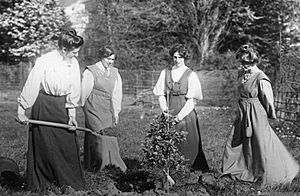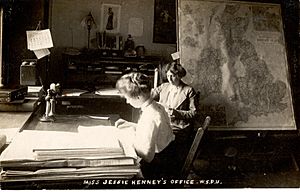Jessie Kenney facts for kids
Quick facts for kids
Jessie Kenney
|
|
|---|---|
 |
|
| Born |
Jessica Kenney
1887 |
| Died | 1985 |
| Nationality | British |
| Occupation | activist and stewardess |
| Relatives | Kitty, Annie, Nell and Jenny (sisters) |
Jessica Kenney (1887 – 1985) was an English activist known as a suffragette. Suffragettes were women who fought for the right to vote in Britain. Jessie was involved in strong protests to help women gain this right. She even faced consequences for confronting the Prime Minister and Home Secretary. Later, she trained to work with radios but ended up working as a stewardess on ships.
Contents
Jessie Kenney's Early Life and Fight for Votes
Jessie Kenney was born in 1887 in Lees, a town near Oldham, England. She was one of twelve children in a large, working-class family. Her parents were Horatio Nelson Kenney and Anne Wood. Five of her sisters, including Caroline (Kitty), Ann (Annie), Sarah (Nell), and Jane (Jennie), were also activists. Annie and Jessie became important leaders in the Women's Social and Political Union (WSPU). Annie, who was eight years older, encouraged her sisters to read and learn.
Jessie started working in a cotton mill when she was just thirteen. Her sisters Annie, Alice, and Jennie also worked there. They all got involved in the local trade union, which helped workers. In 1905, Jessie's mother passed away. That same year, Jessie and Annie became very active in the Women's Social and Political Union (WSPU). They were inspired after hearing Teresa Billington-Greig and Christabel Pankhurst speak at a local club. Jessie was very organized, even though she wasn't as good at public speaking as Annie. In 1906, she became the secretary for Emmeline Pethick-Lawrence. Jessie helped organize members to interrupt meetings and send groups to speak with officials.
Joining the Suffragette Movement
The WSPU used many different ways to push the government to give women the right to vote. They wanted to make sure their message was heard loud and clear.

Creative Protests and Challenges
On September 5, 1908, Jessie, Elsie Howey, and Vera Wentworth protested directly to the Prime Minister, H. H. Asquith, and his Home Secretary, Herbert Gladstone. They followed them during a golf game and later threw stones at the window of their dinner location.
The Post Office rules at the time allowed people to send "human letters." On February 23, 1909, Jessie used this rule to send two delegates, Daisy Solomon and Elspeth McClelland, to the Prime Minister's home. She even told a news reporter about it to get publicity. On April 16, 1909, Jessie was part of a group that met Emmeline Pethick-Lawrence after she was released from Holloway prison. They took her to a special breakfast with 500 WSPU members.
Facing Consequences for Protests
Jessie Kenney and Vera Wentworth were later sent to jail for their strong protests against the Prime Minister. During his summer break, they and Elsie Howey had followed him near his holiday home. They approached him in church and on the golf course, asking why he was on holiday while women were in prison. They also secretly decorated his private garden with leaflets and banners.
On December 10, 1909, Jessie disguised herself as a telegraph boy to try and reach the Prime Minister at a public meeting in Manchester. She wasn't successful, but a picture of the event was used to promote the cause.
Important Meetings and Discoveries
Jessie Kenney and her sister Annie were often invited to Mary Blathwayt's home, Eagle House, where many leading suffragettes met. Important visitors to Eagle House would plant a tree to celebrate their efforts for the cause, especially if they had been to prison. However, when the WSPU started using more militant tactics, like protesting against government ministers, Mary's mother, Emily Blathwayt, decided to leave the WSPU. This also led the Home Secretary, Herbert Gladstone, to consider having police watch activists more closely.
On June 18, 1910, Jessie Kenney led a large procession of 10,000 suffragists and supporters through London on horseback. By 1913, Jessie became ill and was sent to Switzerland to recover. Her illness meant she couldn't destroy some papers in her flat. These papers contained information about the WSPU's protest methods.
Helping During World War I
When World War I began, Emmeline Pankhurst decided to pause the women's suffrage movement to support the war effort. Jessie, like many others, followed her lead.
In June 1917, Jessie went with Emmeline Pankhurst on a trip to Russia. They were there to encourage Russian women to help with the war, on behalf of the British Government. Jessie wrote about this journey, but her writings were never published. During this trip, a union leader named Edward Tupper made sure that certain politicians were not allowed on their ship. However, he made it clear that Jessie and Emmeline Pankhurst were welcome to travel.
A New Path: Wireless and Travel
After her work with the WSPU, Jessie became interested in radio and science. She sought advice from Emmeline Pankhurst and Marie Curie. She realized that she could train to be a wireless operator, even though most operators were men. In 1923, she attended the North Wales Wireless College and earned a top certificate in radio telegraphy, which is sending messages using radio waves.
However, Jessie never found work as a wireless operator. Instead, she worked as a stewardess on ships for companies like Furness and Orient Line.
Jessie's Later Years
During the Second World War, Jessie lived for a while with her sister Annie and Annie's husband in Letchworth. She followed her sister in their spiritual beliefs, moving from Theosophy to the Rosicrucian faith. Jessie later returned to London, working as a school secretary and a welfare assistant. From 1969 until her death in 1985, she was cared for by the Missionary Franciscan Sisters. She became Catholic on Christmas Day in 1973.
External links
- Suffragette Stories (University of East Anglia)


